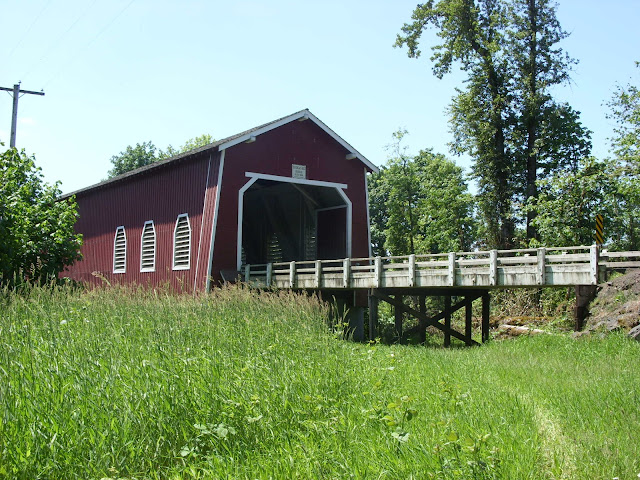One of nine covered bridges along the Covered Bridge Tour Route in Linn County, Oregon, the Shimanek Covered Bridge really stands out among the crowd. Spanning 225 feet across over Thomas Creek on Richardson Gap Road near Scio, it is the only covered bridge in Linn County that is painted red instead of white. This covered Howe truss designed bridge was built in 1966 features portal design and louvered windows which are features similar to the former bridge at this location, which was built in 1927.
The current Shimanek Covered Bridge is the fifth covered bridge at this location over Thomas Creek. This is mostly due to the power of damaging winds and flooding. The first bridge built at this location is believed to have been constructed as early as 1861, while the first documented covered bridge was built in 1891 for a cost of $1,150. In 1904, Linn County rebuilt the bridge, only to have it washed out in 1921. The replacement bridge lasted until 1927, when high water damaged the piers and the span was replaced.
Trees were blown against the fourth covered bridge at this site during the infamous Columbus Day Storm of October 12, 1962. The resulting damage forced the county to restrict the covered bridge to a 2 ton load limit with single lane traffic. Likely because the damages where too much to repair the Shimanek Bridge sufficiently, the bridge was destroyed soon after, and in 1966, the current Shimanek Bridge was opened. Additional repairs to the bridge deck using glue-laminated timber were made after flooding in 1996, and restoration work took place along the bridge in 2022.
It has been rumored that the 1891 bridge had a welcomed accommodation of a two-hole toilet built into the foundation, an accommodation that is not found at the current covered bridge. That might have been interesting to see. Unique features aside, the Shimanek Covered Bridge is worth visiting along a covered bridge tour in the Willamette Valley.
It has been rumored that the 1891 bridge had a welcomed accommodation of a two-hole toilet built into the foundation, an accommodation that is not found at the current covered bridge. That might have been interesting to see. Unique features aside, the Shimanek Covered Bridge is worth visiting along a covered bridge tour in the Willamette Valley.
How to Get There:
Sources and Links:
Bridgehunter.com - Shimanek Covered Bridge 37-22-03
Covered-Bridge.org - Shimanek Bridge
Albany Democrat-Herald - Restoring the Shimanek covered bridge to its former glory (April 19, 2022)
DayTrails - Shimanek Covered Bridge, Scio, Oregon
Pacific Northwest Photoblog - Shimanek Covered Bridge (Thomas Creek)
Linn County, Oregon - Covered Bridge Tour Route




Comments